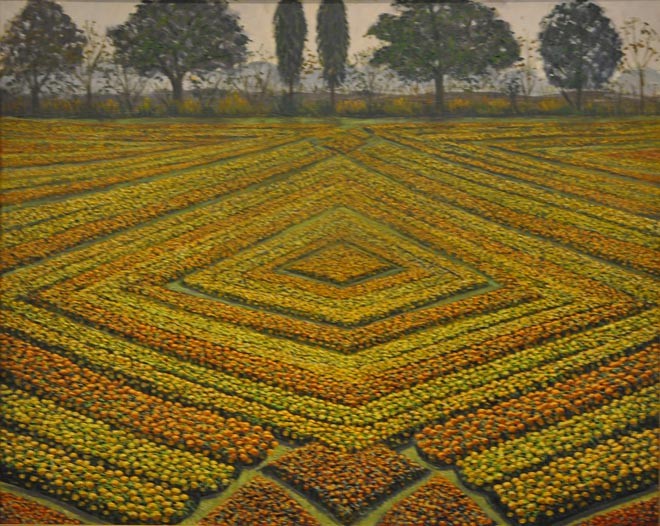
An exhibition at Alhamra Art Gallery brings forth the idea of Pakistani art and culture as it exists in the minds of many

An exhibition of Pakistani artists put together on the occasion of Independence Day celebrations was expected. ‘Colors of Pakistan’, held from August 11-25, 2017 at Alhamra Art Gallery Lahore, was a collection of works by a range of artists. To address the compulsion of living under a ‘federation’, the show included works from Karachi, interior Sindh, Quetta, Peshawar, Northern Areas, Islamabad and different cities of Punjab. It aimed to portray colours of Pakistan in a true sense. Walking through the galleries of Alhamra, one wondered what those colours are.
There were remarkable rural views by Sardar Assef Ahmed Ali, Kaleem Khan, Abid Khan and Nazir Ahmed. Experiments within the genre of landscape were witnessed in the canvases of Shahid Jalal, Ali Azmat and Maliha Agha. There also were figurative but not conventional works like self-portraits by Rahat Naveed Masud and R. M. Naeem; models posing as singular figure or part of groups for instance in the works of Ijaz ul Hassan, Shahnawz Zaidi, Musarrat Hasan, Iqbal Hussain, Muhammad Ali Bhatti and Sumera Jawad.
All these paintings, most of which were created not on the theme of representing Pakistan, suited well to commemorate the Day of Independence. Gathered from artists’ collections or from other sources, they all suggested the colours of Pakistan. One heartening aspect was that the show exhibited a number of artists working far from centres of local art circles.
A cursory comparison of works collected in this show may illustrate how differently identity is perceived in various parts of the country. There were references to Islamic calligraphy made by ‘Chitra Pritam’, women of Sindh in the paintings of Muhammad Ali Bhatti, dilapidated structures in the old part of Lahore in Ajaz Anwar’s watercolours, narrow and busy city streets in the canvases of Ghulam Mustafa, Mehboob Ali and Zulfiqar Ahmed Zulfi, and attempts at depiction of indigenous people by Abrar Ahmed and Saeed Akhtar.
Overall, the exhibition brings forth the idea of Pakistani art and culture as it exists in the minds of many: pretty village maidens; peaceful pastures; happy characters in their homes and at work; heritage both in architecture and religious scripts; nomadic tribes of Sindh and Balochistan; river in tranquil environment (Mughees Riaz); and beautiful meadows (Muhammad Arshad and Abid Khan).
But are these the colours of Pakistani culture or art or do they exist beyond typical, touristy and temporary notions?
One must recognise the efforts of Zulfiqar Ahmed Zulfi, Director of Arts and Culture of Alhamra Art Council, in organising an art event on the 70th independence day. Considering the constraints of nationalism, this was perhaps the best exercise possible. At least, it offered an ordinary visitor a chance to look at some interesting art works, instead of the usual fare -- badges, pins, posters, stickers and large flags -- on sale for profit in the name of national day festivities.
In a reverse way, the artists are trying to portray the ingredients of national identity in order to sell something that is vernacular, unique and hence attractive. You can imagine an artist leaving his comfort zone for scorching heat, flies, noise, dust and dirt on a roadside or in a village. The real motive could be to sell that ‘scene’ to connoisseurs who appreciate these rustic views.
Images of these areas, whether rural or urban, fetch high returns in the local market where, even if you don’t have the power to purchase the works of established artists, you still appreciate their love for the land. As for foreign buyers, they are looking more for modern miniature or contemporary art.
The reason why landscape painting is so popular in the art of Pakistan, especially Punjab, is that art forms are not mere academic exercises; they have political, societal and economical bases. Landscape was never a genre in the art of traditional societies. As a theme, according to V.S. Naipaul, it was popularised by shipping companies to attract tourists to far off exotic locations. In our history, too, landscape was captured by colonial soldiers or their companions to document an exotic land. So, landscape mostly signifies an outsider’s views and point of view.
In a sense, the practice of making landscape may not be separated from the accounts of travellers to distant regions in which they incorporate observations of a land distinct from their own surroundings. For some painters of our times, the immediate reality of their existence is as remote as their depictions of pastoral or urban scenarios. Some works from the exhibition ‘Colors of Pakistan’, however, were not limited to a particular locale; these encompassed ideas which are shared by people across cultures and continents. In particular, two canvases of Ijaz ul Hassan, both rendered in blue, in which a single figure on a crossroads or two men (Conspirator) are painted. These offer a glimpse into human beings who are alone or in conversations, but are watched and are open to multiple and diverse interpretations.
Looking at the work of Ijaz ul Hassan from the ‘Colors of Pakistan’, one realises that art -- and life -- exist beyond the barriers of seventy years of a nation even though these still define our art, politics and culture to an extent.